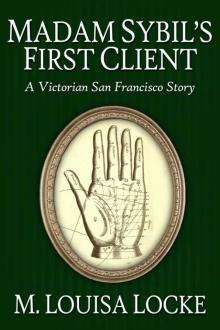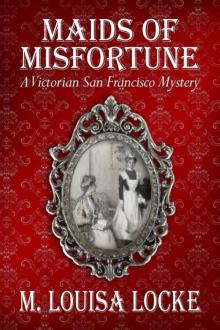- Home
- M. Louisa Locke
Pilfered Promises Page 6
Pilfered Promises Read online
Page 6
“So, Madame Dawson, a woman who shops at the Silver Strike Bazaar does so knowing she will never suffer the embarrassment of encountering another woman wearing the same hat,” Villeneuve concluded with pride. “Now, do come and meet my wonderfully talented wife.”
They wended their way across the room toward a handsome woman who was standing near one of the back tables and deftly tweaking a trio of blue dyed feathers on a hat before returning it to a worker. She was tall, perhaps nearly as tall as her husband, and very fashionably dressed, wearing an exquisitely tailored suit of pale pink silk—the same shade as her husband’s boutonnière and vest. The bodice was trimmed with burgundy velvet on the lapels and cuffs and it was buttoned obliquely in a fashion that emphasized a waist that her husband’s long slender hands could easily encompass. The underskirt was constructed in three alternating rows of knife-sharp pleats and burgundy embroidered roses. Her soft oval face, with a nose that was just the right length, a pair of lips whose natural rose matched her dress, and dark brown eyes, the exact shade of her intricately styled hair, completed the picture of stylish perfection.
Annie repressed a momentary feeling of inferiority, remembering the negative comments she’d endured from John, her first husband, on her “pedestrian” looks, lack of fashion sense, and her wretched freckles. His constant derision, combined with the fulsome praise he heaped on other women in their New York social circle, had taken its toll. And his death didn’t end the scorn. His mother repeatedly pointed out how unlikely it was that anyone would ever want to marry Annie again, saying, “My dear, a penniless woman who is so plain has no future.” Which, of course, was why she believed her former daughter-in-law should be grateful to live as an unpaid companion to anyone in the extended Fuller clan who needed her services.
I hope she choked on her words when she read the announcement I sent her of my marriage to Nathaniel Dawson, Esquire.
Annie then chided herself for feeling jealous of Madame Villeneuve. No woman who woke each morning to Nate’s adoring eyes needed to feel one whit inferior to any other woman.
“Madame Dawson, I am pleased to introduce to you my wife, Hortense Villeneuve, the woman who, with the forbearance of a saint, has put up with me all these years. Ma chère, Robert has asked Madame Dawson to advise him on his business affairs, so I have agreed to show her around our atelier du travail…our little fourth floor workshop. It seems that Madame Dawson is the daughter of someone for whom Robert had great admiration, and she has inherited her father’s genius in matters financial.”
Annie was glad to see that Villeneuve hadn’t confided in his wife about the real reasons she was here, but she was intrigued when Madame Villeneuve’s brief look of irritation at being interrupted was replaced rapidly by a warm smile when her husband had mentioned that Annie was there under Mr. Livingston’s auspices. She wondered if the decision to bring Adolphe Villeneuve in as a partner had anything to do with the addition of his very beautiful wife to the firm.
As Monsieur and Madame Villeneuve escorted Annie around the workroom, she couldn’t help but be impressed by the sheer variety in styles the workshop produced, from matronly bonnets of lace and satin, trimmed with ruching and ribbons, to daring confections with wide flat brims on which perched flowers and stuffed birds. Even the more simple straw boaters and porkpie styles provided ample opportunities for the workers’ imaginations. Villeneuve proudly pointed out the different kinds of feathers, rolls of silk and satin ribbons in a rainbow of colors, artificial fruits and flowers, as well as the velvet, silk, satin, toile, chiffon, lace, and netting available for the women to use in trimmings.
Despite the fact that she thought many of the hats absurdly over-decorated, Annie suspected every one of them would delight some Silver Strike shopper. She’d even found herself coveting a jaunty pale blue velvet riding hat, adorned with three sapphire-colored feathers, which would look perfect with her newest dress.
“Our hats are superior to any you will find at the absurdly named City of Paris,” Madame Villeneuve said, lovingly stroking a hat that looked to Annie like a lace-covered upside-down flowerpot. “The Verdiers were nothing but petite bourgeoisie from the provinces when they came to the city thirty years ago. What do they know of the great artistes of Paris? The woman they employ to design…if you can call it design…their millinery has no more sense of style than a fishwife.” She then shrugged expressively and smiled at Annie, saying, “But I can tell you are a woman of good taste. You will permit me to design a hat for you extraordinaire.”
Before Annie could respond, one of the workers came up to Madame Villeneuve, holding out a simple blue bonnet trimmed with daisies dyed a darker shade. The Frenchwoman frowned and said, “Mais non. This will not do. Please excuse me, Madame Dawson. I must attend to my duties. If I do not watch these women like a hawk…”
Monsieur Villeneuve said hastily, “Certainly, certainly, my chérie.” Taking out his pocket watch, as if there weren’t a huge clock mounted on the work room wall, Villeneuve said, “In any case, I see it is time for us to meet with Madame Fournier. Ah, there is l'enfant Emmaline, come to remind us.” He waved enthusiastically at someone over Annie’s shoulder. Someone who’d disappeared before Annie could turn around to see who “the child Emmaline” was and why she’d elicited such a wide smile from Madame Villeneuve.
It was Mrs. Marie Fournier herself who met them at the door of the first of the three workshops that housed the seamstresses, and she was clearly not a child. A woman in her early thirties, she was of medium height and dressed in a simple basque-style suit of dark brown wool with a high collar, long narrow sleeves, and a matching pleated underskirt of silk. The trimmings were minimal, a touch of white lace at neck and cuffs, and a very narrow flounce at the bottom of the skirt.
Tasteful, the outfit complemented her creamy complexion and hazel eyes and accentuated her fragile beauty without being showy––a definite contrast to the impression left by Madame Villeneuve’s ensemble, even though, according to Monsieur Villeneuve, Mrs. Fournier had designed his wife’s outfit. This reminded Annie of Miss Minnie and Miss Millie Moffet, the two elderly dressmakers who boarded with her. Their own black silk dresses were beautifully made, but they didn’t even hint at the innovative creations they designed for their clients, some of the wealthiest women in San Francisco.
“Mrs. Dawson, I understand from Mr. Livingston that you are interested in seeing how the Silver Strike is able to provide such high quality goods for our customers,” Mrs. Fournier said, her voice soft with just the slightest hint of a southern accent.
“Yes, Mrs. Fournier. I believe that you have over a hundred people working under you. Do you do all the design work yourself?”
“Oh my, no. We have a tailor and apprentices who create the patterns and cut the material for the men’s shirts.” Leading Annie and Villeneuve into a room about the size of the millinery work room, she said, “As you can see, once the material is cut, the sewing is then divided up between those women who use sewing machines to do the seam work and our more skilled workers who do the hand finishing.”
The room was filled by two long rows of tables where women sewed at foot-pedaled machines, filling the air with whirrs and clatters, and rows of tables on both sides where the finishers worked quietly on stacks of shirts and children’s underwear. Here white cotton muslin and an occasional blue flannel predominated. In contrast, the next room, where children’s and women’s suits and shirtwaists were made, burst with a riot of color in every conceivable material. This second work space, while it contained as many people, felt much less like a factory, probably because of the variety of kinds of clothing being produced. There were fewer women sewing on machines, with the majority of the seamstresses engaged in the work of hand sewing tucks, pleats, and embroidery on girls’ short dresses, boys’ shirtwaists, and women’s suits.
“How many different styles of women’s suits do you make here?” Annie asked as she moved through to this second room. “And are you respon
sible for all these designs, Mrs. Fournier?”
“I consult with the tailor on staff for the boys’ shirtwaists, but all the girls’ and women’s dresses are designed by me…in consultation with Monsieur Villeneuve, of course. Monsieur has impeccable taste as well as numerous contacts among the Paris designers, so his advice is invaluable.”
“Madame, you are too kind.” Villeneuve smiled warmly.
Quite the mutual admiration society. Annie wondered if this was what had caused Madame Villeneuve to purse her mouth briefly in irritation when her husband first mentioned their appointment with Mrs. Fournier.
“As to your question of styles,” the dress designer continued. “We try to have at least fifteen to twenty distinct outfits featured at a time. However, we make each garment in several colors and materials, so in reality our customers have sixty or more different ensembles to choose from. For example, this dress I am wearing, one of our ready-made fall suits, also comes in silk and in a complementary beige and two different shades of green.”
“You also change the styles seasonally?” Annie knew the busiest times for the Moffets came twice a year when their regular clients ordered new clothes for the spring and summer season and then again for the fall and winter. No society woman wanted to experience the humiliation of being seen wearing an outfit that followed last year’s out-of-date Paris fashion.
As if reading her mind, Mrs. Fournier said, “Yes, we make every attempt to stay current…but we recognize that most of the women who buy ready-made outfits from us can’t afford to change their entire wardrobes when Paris or New York designers decide that this fall all bustles should be one inch lower or all ruffles one inch shorter than last year. So we try to create clothing that can be easily combined with bodices or underskirts from a previous year to keep a wardrobe up-to-date.”
Annie, who only recently began replacing the black mourning clothes she’d been wearing since her first husband’s death, nodded appreciatively. Currently, she only owned four outfits: a serviceable brown wool polonaise, the navy wool basque she was wearing today, a royal blue evening gown of velvet and satin, and the lovely sapphire and ivory silk dress she’d commissioned for her wedding in August. And Annie knew that it was only the dressmaking ingenuity of the two Moffet sisters that kept her from feeling embarrassed when she met with her more well-to-do clients.
Villeneuve said, “Madame Fournier is too modest. She does not need to follow my advice or mimic the designers elsewhere. She is a genius in her own right.”
The Frenchman went on to tell Annie how he’d met Mrs. Fournier years earlier when his wife had bought an evening gown from her at her shop on Green Street. How hard he’d had to plead with her to get her to leave this shop behind to join the Silver Strike Bazaar two years ago. He concluded by grandly stating, “Because of her talents, a woman who buys a Silver Strike garment, whether ready-made or custom made, is buying a conception originale d'une grande beauté.”
“You are too kind, Monsieur,” Mrs. Fournier murmured, her southern accent deepening.
Annie, alert as always to nuances, thought there was almost a reproach in the dress designer’s statement. Discomfort with Villeneuve’s fulsome praise and the tension it might cause between her and his wife? Or something else? And who could she ask to find out about the nature of relations between Villeneuve, his wife, and Mrs. Fournier? She knew she was supposed to be looking into financial problems with the firm, but her experience said personal relationships often held the clue to economic motives.
At this point in the tour, they entered the third workshop under Mrs. Fournier’s management. Here, Villeneuve told Annie, was where the exclusive, custom-made dresses were constructed, and she could tell that it was in this space that the dressmaker felt most at home. There had been pride in her voice when she spoke about the ready-made garments she’d designed. But Annie heard love, not just pride, when Mrs. Fournier showed her each of the garments hanging on dress forms, pointing out the particular design choices she’d made, the innovations in style, and the handwork that had gone into the embellishments.
“Do you personally meet with the women you design for?” Annie asked.
“Yes. I reserve early evenings for appointments for initial consultations and later fittings, when the store is closed. And, while I have my best seamstresses working with me, I confess I like to do much of the hand-work myself in the evenings.”
Before Annie could ask any further questions, a young woman came in from the adjoining work room to consult with Mrs. Fournier. Annie looked at the clock on the wall, not surprised to see that it was nearly noon and time to join Mr. Livingston for lunch.
She’d just told Monsieur Villeneuve she needed to go when the young seamstress talking to Mrs. Fournier let out a startled exclamation. “Mrs. Fuller…I mean Mrs. Dawson, whatever are you doing here?” Then, blushing profusely, the freckle-faced girl bobbed a curtsey to her employers, stammering out apologies for her outburst.
Annie broke in, saying, “That’s all right, Bridget.” She then turned to Mrs. Fournier and Villeneuve, saying, “Miss O’Malley is a family friend whom I’ve not seen since my recent marriage.”
Annie smiled warmly at the girl, who was actually a friend of her maid, Kathleen, as well as the cousin of Tilly, her other maid. She said, “It has been too long since we have had a visit from you. Do stop by when you get a chance.”
She then made her polite good-byes, thinking with satisfaction, as she made her way back to Miss Birdsoll’s office, how useful it was going to be to have the very resourceful Bridget O’Malley, otherwise known as Biddy, as a source of inside information about the Silver Strike Bazaar and its employees. And if I know Biddy, I will see her at the boarding house before the day has ended.
Chapter 5
“Women wishing ARTISTIC and Stylish Dresses should not fail to leave their orders with us.”––San Francisco Chronicle November 14, 1880
Monday evening, November 15, 1880
Kathleen carefully tested the iron she’d taken off the stove on a scrap of linen to ensure it was the right temperature…not so hot it would singe the material, nor so cool that it wouldn’t remove the wrinkles. Now that Tilly was working full-time and could take care of clearing the table and doing the dishes on wash day, Kathleen liked to iron the men’s shirts in the evening when they were just the right dampness. Otherwise, she’d have to sprinkle them again in the morning, which was always hit or miss in terms of how they would iron. The sheets, table cloths, and other flat linens done by the laundress this morning could wait and were sitting folded in the great wicker baskets in the pantry.
Taking care of the two clerks who boarded together on the second floor was easy. They only had eight shirts between them. However, Mr. Stein, as befitted a well-to-do businessman, often changed his shirts once a day, particularly when he and Mrs. Stein were going out to dinner or the theater. Not that she minded ironing for him. He was ever so nice a gentleman, and his shirts were of such fine linen, they practically ironed themselves.
But now she also had the master’s shirts to iron, and it pained her to see how badly treated they’d been by the servants in his old boarding house. Shameful! She’d done what she could to reinforce all the stitching and bleach out as many of the stains as possible. But nothing could repair the numerous scorch marks. At least Mrs. Dawson had promised Kathleen she’d get him some new shirts for Christmas.
A sharp rap at the back kitchen door interrupted this thought, and Kathleen looked over at Mrs. O’Rourke, who was getting the dinner leftovers ready to put away. “Who’d you suppose it would be this time of the evening?”
“I’ll get it,” Mrs. O’Rourke said, wiping her hands on her apron. “You mind your iron.”
When the older woman opened the back door, she exclaimed, “Well, Bridget O’Malley. You are a sight for sore eyes.” Then her voice sharpened. “Nothing’s wrong with your ma or one of the little ones? Tilly’s upstairs clearing the table. Do I need to get her?”
<
br /> The girl, her thick auburn hair in disarray and her cheeks red from the cold, swept into the room like a gust of wind, saying, “No, Mrs. O’Rourke, don’t you worry. All’s fine at home. It were your mistress who asked me to stop by. Ran into her today. Made a fool of myself calling her Mrs. Fuller. Although I must say marriage does seem to agree with her.”
“Oh my stars,” said Kathleen. “Biddy, I completely forgot you’d gotten a job at the Silver Strike. Is that where you saw her? Did she tell you what she’s working on?”
“Kathleen,” Mrs. O’Rourke said, “give the girl a chance to catch her breath and get warm. Oh, here’s Tilly.” She trotted over to take the tray piled with the last of the dessert dishes from the young Irish maid, saying, “My dear, could you run upstairs to Mrs. Dawson’s room, please? Tell her your cousin’s come.”
Tilly bobbed a curtsey, mouthing a soft, “Yes, ma’am,” then disappeared back up the stairs.
Mrs. O’Rourke put the tray down on the kitchen table and went over to put the kettle back onto the stove top to boil. Then noticing that Biddy had already grabbed an apron from the hook by the back door and was starting to put the dishes into the sink, cried, “Bridget girl, you just stop that and sit down and fill us in on your family while we wait to see if Mrs. Dawson wants you to come upstairs to her.”
Kathleen winked at her friend then went back to the ironing. Wasn’t that just like Biddy to try to pitch in even though she’s probably been at work for ten hours already.

 Scholarly Pursuits
Scholarly Pursuits Lethal Remedies
Lethal Remedies Victorian San Francisco Stories
Victorian San Francisco Stories Madam Sibyl's First Client: A Victorian San Francisco Story
Madam Sibyl's First Client: A Victorian San Francisco Story Uneasy Spirits: A Victorian San Francisco Mystery
Uneasy Spirits: A Victorian San Francisco Mystery Dandy Detects: A Victorian San Francisco Story
Dandy Detects: A Victorian San Francisco Story Pilfered Promises
Pilfered Promises Dandy Delivers
Dandy Delivers Kathleen Catches a Killer
Kathleen Catches a Killer Violet Vanquishes a Villain
Violet Vanquishes a Villain Maids of Misfortune: A Victorian San Francisco Mystery
Maids of Misfortune: A Victorian San Francisco Mystery